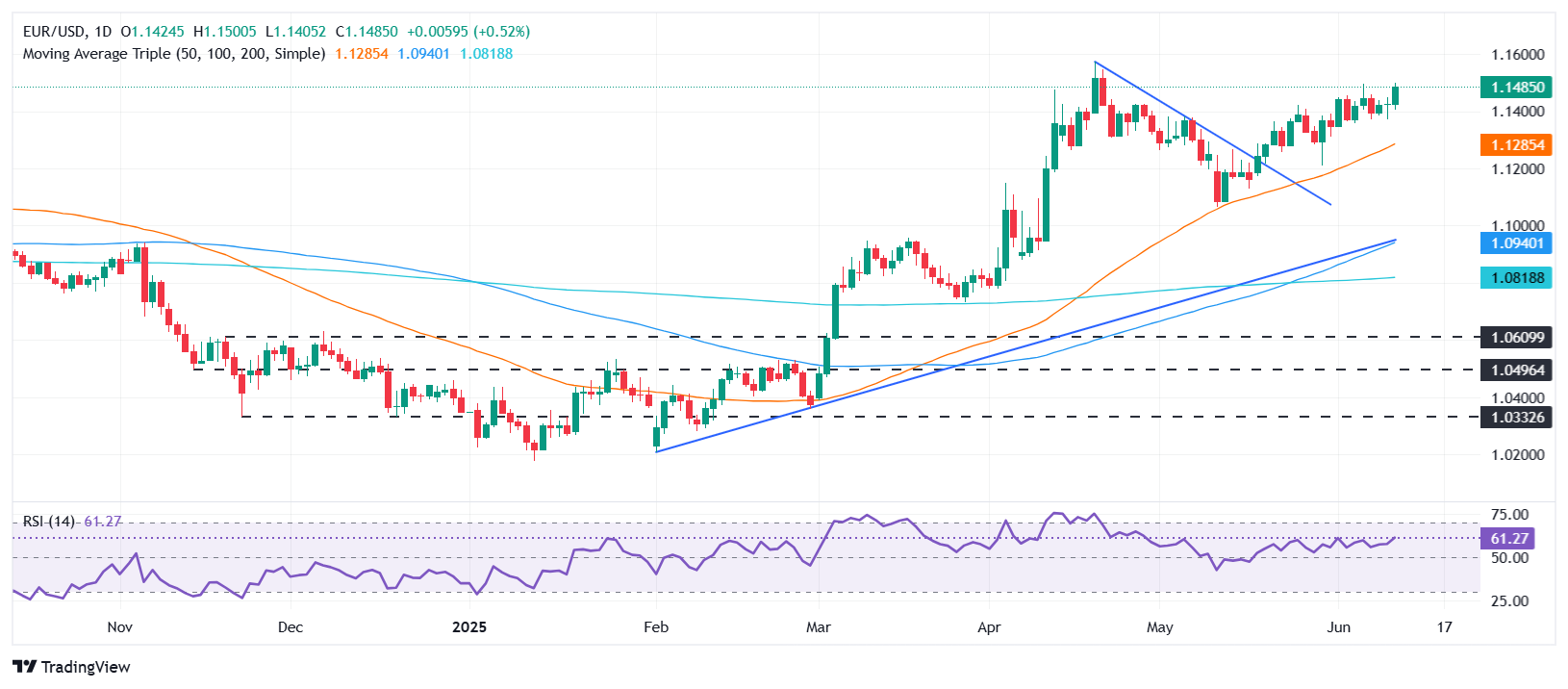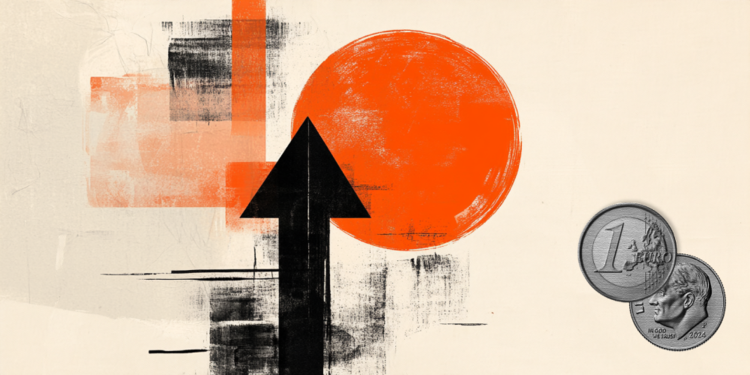- EUR/USD advances as lower US inflation sparks calls for aggressive Fed rate cuts.
- Trump urges full percentage point cut in Fed funds rate post-CPI.
- ECB policymakers cautious, but inflation outlook hints at further fine-tuning.
The EUR/USD surged during the North American session but remains shy of clearing the 1.1500 figure, following the release of a softer-than-expected inflation report in the United States (US), which could prompt the Federal Reserve (Fed) to reduce borrowing costs in the near term. At the time of writing, the pair trades at 1.1482, up by over 0.50%.
US data revealed that the Consumer Price Index (CPI) in May fell short of estimates as prices continued to trend lower. Following the data release, US President Donald Trump posted on his social network that the Fed should lower the fed funds rate by one whole percentage point.
Although inflation edged lower, some analysts project that households in the upcoming month will feel the impact of tariffs. Meanwhile, positive trade news regarding negotiations between the US and China emerged, as the Wall Street Journal (WSJ) revealed that China is putting a six-month limit on rare-earth export licenses for US automakers and manufacturers.
Meanwhile, in the Eurozone (EU), European Central Bank (ECB) policymakers made headlines, although they failed to move the EUR/USD pair. The ECB’s Vujcic said that he is looking for more clarity on trade, while Kazaks noted that it is “quite likely that 2% inflation will require some further cuts for fine-tuning,” said via Econostream on X.
The ECB Chief Economist, Philip Lane, added that last week’s rate cut helped clarify the bank’s policy stance to bring inflation toward its target.
Ahead in the week, the EUR/USD is expected to be greatly influenced by the release of the US Producer Price Index (PPI) numbers, along with the Initial Jobless Claims report. Across the pond, the EU’s schedule is scarce on economic data, but ECB officials led by Vice-President Luis de Guindos will cross the wires.
Euro PRICE This week
The table below shows the percentage change of Euro (EUR) against listed major currencies this week. Euro was the strongest against the US Dollar.
| USD | EUR | GBP | JPY | CAD | AUD | NZD | CHF | |
|---|---|---|---|---|---|---|---|---|
| USD | -0.85% | -0.19% | -0.32% | -0.19% | -0.12% | -0.23% | -0.28% | |
| EUR | 0.85% | 0.65% | 0.51% | 0.65% | 0.76% | 0.62% | 0.56% | |
| GBP | 0.19% | -0.65% | -0.04% | 0.00% | 0.12% | -0.03% | -0.08% | |
| JPY | 0.32% | -0.51% | 0.04% | 0.12% | 0.15% | 0.03% | -0.08% | |
| CAD | 0.19% | -0.65% | -0.01% | -0.12% | 0.06% | -0.04% | -0.09% | |
| AUD | 0.12% | -0.76% | -0.12% | -0.15% | -0.06% | -0.14% | -0.19% | |
| NZD | 0.23% | -0.62% | 0.03% | -0.03% | 0.04% | 0.14% | -0.05% | |
| CHF | 0.28% | -0.56% | 0.08% | 0.08% | 0.09% | 0.19% | 0.05% |
The heat map shows percentage changes of major currencies against each other. The base currency is picked from the left column, while the quote currency is picked from the top row. For example, if you pick the Euro from the left column and move along the horizontal line to the US Dollar, the percentage change displayed in the box will represent EUR (base)/USD (quote).
Daily digest market movers: EUR/USD soars past 1.1480 as traders shift toward US PPI data
- EUR/USD appears poised to test the 1.1500 mark in the near term as positive news about US-China talks could increase appetite for riskier assets and weigh on the US Dollar.
- US Treasury Secretary Scott Bessent commented that trade fairness with China could be achieved through reduced exports to the US or by rebalancing the world’s largest economies. He added that the Trump administration is committed to maintaining the US Dollar’s reserve currency status.
- US inflation came in softer than expected in May. Headline CPI rose 2.4% YoY, slightly above April’s 2.3% but below the 2.5% forecast. Core CPI held steady at 2.8% YoY, suggesting underlying inflation remains stable but persistent.
- The PPI for May is projected to increase from 2.4% to 2.6% YoY. Underlying PPI figures are expected to remain at 3.1% higher, unchanged compared to April’s print.
- Financial market players do not expect that the ECB would reduce its Deposit Facility Rate by 25 basis points (bps) at the July monetary policy meeting.
Euro technical outlook: EUR/USD bulls eyes 1.15 and the YTD high
From a technical perspective, the uptrend is expected to continue as buyers target a clear break above the 1.1500 figure. This will expose the year-to-date (YTD) high of 1.1572, ahead of 1.1600. The Relative Strength Index (RSI) is bullish, indicating an upward direction, which suggests that buyers are gaining momentum.
The less likely scenario on the downside is that the EUR/USD needs to clear the 1.1450 area. This would set the pair for a pullback toward the 20-day Simple Moving Average (SMA) at 1.1346 before testing 1.1300.

ECB FAQs
The European Central Bank (ECB) in Frankfurt, Germany, is the reserve bank for the Eurozone. The ECB sets interest rates and manages monetary policy for the region.
The ECB primary mandate is to maintain price stability, which means keeping inflation at around 2%. Its primary tool for achieving this is by raising or lowering interest rates. Relatively high interest rates will usually result in a stronger Euro and vice versa.
The ECB Governing Council makes monetary policy decisions at meetings held eight times a year. Decisions are made by heads of the Eurozone national banks and six permanent members, including the President of the ECB, Christine Lagarde.
In extreme situations, the European Central Bank can enact a policy tool called Quantitative Easing. QE is the process by which the ECB prints Euros and uses them to buy assets – usually government or corporate bonds – from banks and other financial institutions. QE usually results in a weaker Euro.
QE is a last resort when simply lowering interest rates is unlikely to achieve the objective of price stability. The ECB used it during the Great Financial Crisis in 2009-11, in 2015 when inflation remained stubbornly low, as well as during the covid pandemic.
Quantitative tightening (QT) is the reverse of QE. It is undertaken after QE when an economic recovery is underway and inflation starts rising. Whilst in QE the European Central Bank (ECB) purchases government and corporate bonds from financial institutions to provide them with liquidity, in QT the ECB stops buying more bonds, and stops reinvesting the principal maturing on the bonds it already holds. It is usually positive (or bullish) for the Euro.

